
Myrsine howittiana, the brush muttonwood or muttonwood, is a shrub or small tree in the family Primulaceae. The species is endemic to eastern Australia.

Hibiscus splendens, the splendid hibiscus, is a species of flowering shrub or tree in the mallow family, Malvaceae. Other common names include hollyhock tree and pink cottonwood. H. splendens is a fairly common plant native to eastern Australia. The range of natural distribution is from Wollongong in the state of New South Wales to Blackdown Tableland National Park in central east Queensland. The habitat is on clearings or disturbances around the margins of the drier rainforests.

Trochocarpa laurina is an Australian shrub or small tree. It occurs from near Bermagui in southern coastal New South Wales to the Wet Tropics in Queensland. It grows at the summit of Mount Bellenden Ker, which has an average annual rainfall of 8312 mm. The minimum annual rainfall requirement is 1200 mm.

Rapanea variabilis, known as the muttonwood or variable muttonwood is a tree of eastern Australia. The range of natural distribution is from near Milton in southern New South Wales to the McIlwraith Range in far north Queensland.
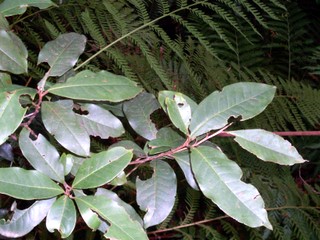
Quintinia sieberi, known as possumwood, is a rainforest tree of eastern Australia. It is mostly found in rainforests at high altitude. The range of natural distribution is between the Clyde River, New South Wales and the McPherson Range just over the border in the state of Queensland.
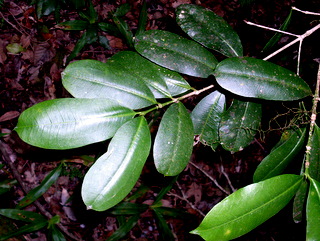
Baloghia inophylla is a rainforest tree of eastern Australia. It is also known as the brush bloodwood, as it occurs in brushes,, as well as bloodwood, as the clear sap is blood red. Other common names include ivory birch and scrub bloodwood.

Streblus brunonianus, known as the whalebone tree, is a small tree in the fig family. Commonly seen in a variety different types of rainforest, particularly by streams.

Macaranga tanarius is a plant found in South East Asia, Thailand, Papua New Guinea, Taiwan, and eastern Australia. It is commonly seen as a pioneer species in disturbed rainforest areas. Easily recognised for the round veiny leaves. In Australia it naturally occurs from the Richmond River, New South Wales to Cooktown in tropical Queensland.

Maytenus silvestris is a shrub or small tree growing from Picton, New South Wales near Kroombit Tops, near Gladstone, Queensland. It occurs in dry rainforest, eucalyptus and rainforest ecotone areas. Common names include narrow leaved orangebark, orange bush and orange bark.
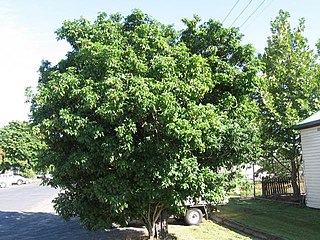
Harpullia pendula, known as the tulipwood or tulip lancewood is a small to medium-sized rainforest tree from Australia. The tree's small size, pleasant form and attractive fruit ensures the popularity of this ornamental tree. The range of natural distribution is from the Bellinger River in northern New South Wales to Coen in tropical Queensland. Tulipwood occurs in various types of rainforest, by streams or dry rainforests on basaltic or alluvial soils. In tropical and sub tropical rainforest. Often seen as a street tree, such as at St Ives, New South Wales.

Alchornea ilicifolia, commonly known as the native holly is a bush of eastern Australia. Growing in or on the edges of the drier rainforests, from Jamberoo, New South Wales to Atherton, Queensland.
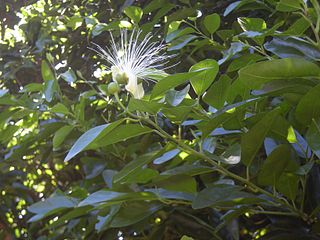
Capparis arborea is a bush or small tree occurring in eastern Australia. The habitat is rainforest; usually riverine, littoral or the drier rainforests. Distributed from the Hunter River, New South Wales to Cape Melville in tropical Queensland. Common names include native pomegranate, wild lime, wild lemon and brush caper berry.

Mischocarpus pyriformis, known as the pear fruited tamarind is a rainforest tree of eastern Australia. Occurring from Seal Rocks, New South Wales to as far north as Cooktown in tropical Queensland. The sub species found in New South Wales is Mischocarpus pyriformis subsp. pyriformis.

Pomaderris aspera is a plant from eastern and southern Australia. Mostly seen south of the Barrington Tops in New South Wales to as far south as Wilsons Promontory and Cape Otway on the mainland. Also occurring in Tasmania. Scattered individuals are found in northern New South Wales to as far north as Bunya Mountains National Park in Queensland.

Endiandra introrsa is a rare rainforest tree growing in eastern Australia. Listed with a Rare or Threatened Australian Plants (ROTAP) rating of 3RCa. Its habitat is warm temperate rainforest on the poorer rainforest soils, mostly over 300 metres in altitude, and its range of natural distribution is from near Dorrigo to various sites in the state of Queensland.
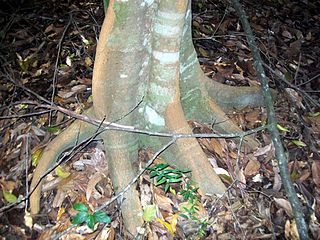
Endiandra muelleri is a rainforest tree of eastern Australia. Its habitat is in warm temperate rainforests on poorer soils. Distributed from the Allyn River in the Barrington Tops region in the south to Kroombit Tops to the north in central Queensland.

Xylosma terrae-reginae is a rainforest tree of eastern Australia. The habitat is in sea side or relatively dry rainforest areas, mostly on private property. Found as far south as Ballina, New South Wales to as far north as near Maryborough, Queensland. It is listed as endangered by extinction. As this is a relatively unknown plant, it has no common name as such, apart from the generic name Xylosma.

Petalostigma triloculare, known as the long-leaved bitter bark is a rainforest tree of eastern Australia. It occurs in the drier rainforests, often on sandy soil derived from granite or sandstone, and is sometimes seen on old sand dunes.

Quintinia verdonii, commonly known as the grey possumwood, is a tree of eastern Australia. It is mostly found in rainforests at high altitude. The range of natural distribution is between the Barrington Tops region of New South Wales and the Blackall Range in the state of Queensland.

Pilidiostigma glabrum, the plum myrtle, is a small tree or shrub native to the rainforests of eastern Australia. Commonly seen in disturbed sites from near Port Macquarie in the south to Fraser Island in the north.



















